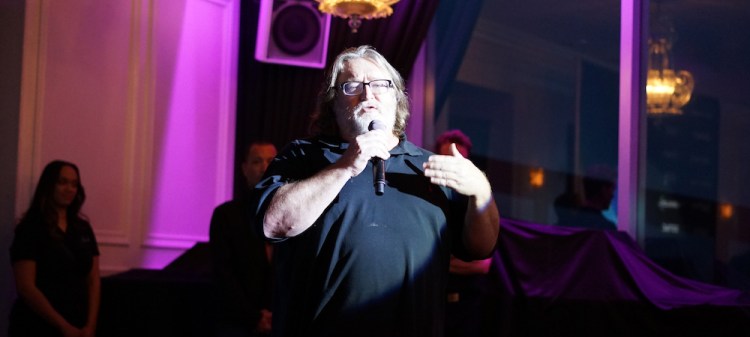Click here for all of GameBeat’s 2015 Game Developers Conference coverage.
Valve loves introducing new products at the Game Developers Conference, and the 2015 show is no different.
The company today revealed its next graphics engine, Source 2. It also announced the Steam Link, which is a $50 in-home streaming box that sends games from a PC to a television. The final Steam Controller will also debut alongside that for $50. For VR, Valve said that the controller will have touch and motion, and it also revealed Steam Lighthouse, which enables headsets and other VR equipment to quickly gauge the size of the room the player is in.
“In order to have a high-quality VR experience, you need high-resolution, high-speed tracking,” Valve VR engineer Alan Yates said. “Lighthouse gives us the ability to do this for an arbitrary number of targets at a low enough [cost] that it can be incorporated into TVs, monitors, headsets, input devices, or mobile devices.”
Valve will make Lighthouse free for any hardware manufacturer interested in the technology. These VR add-ons come just days after smartphone and tablet manufacturer HTC revealed it is partnering with Valve to build a VR headset. The companies confirmed this new entry in the market will include Lighthouse and work with the Steam controller.
The company is also finally talking about Source 2, which it says is the successor to the Source engine that powered Valve games like Half-Life 2.
“The value of a platform like the PC is how much it increases the productivity of those who use the platform,” Valve technology specialist Jay Stelly said. “With Source 2, our focus is increasing creator productivity.”
But Valve isn’t just targeting game developers with Source 2. It made it very clear that it wants individual community members using the engine to build player-created content for PC games. This is a concept Valve has spearheaded with its Dota 2 multiplayer online arena battler, its Counter-Strike: Global Offensive shooter, and its other shooter Team Fortress 2. Valve splits revenues with community creators, and it has already shared millions of dollars with the people making hats and other items for its games.
“Source 2 is designed not for just the professional developer, but enabling gamers themselves to participate in the creation and development of their favorite games,” said Stelly. “We will be making Source 2 available for free to content developers. This combined with recent announcements by Epic and Unity will help continue the PCs dominance as the premiere content authoring platform.”
Epic’s Unreal engine and Unity’s game-creation engine are both free for developers. Valve’s release didn’t say anything about game makers paying after shipping a game — Epic, for example, requires a 5 percent cut as a royalty for using Unreal Engine 4.
Finally, Steam Link is the latest manifestation of Valve’s Steam Machine initiatives. This $50 set-top box enables hardcore PC gamers to use their powerful machines to run Steam releases on a TV without having to run an HDMI capable from an office to the living room.
It supports 1080p and 60 frames per second at a low latency, according to Valve. It launches in November.
This is a space that has started to see some more action with companies like Nvidia introducing a way for people with an Nvidia graphics card to broadcast games locally to an Nvidia tablet or portable device. The tablet, called Nvidia Shield, even connects to TVs via an HDMI cable.
But a $50 device that works with any brand of graphics cards — and from a trusted company like Valve — could break open the market.
VentureBeat's mission is to be a digital town square for technical decision-makers to gain knowledge about transformative enterprise technology and transact. Learn More

